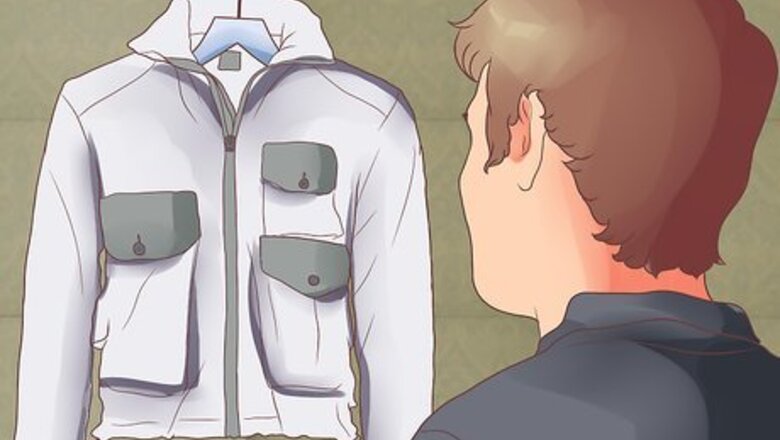
views
Acquiring Materials and Setting Up
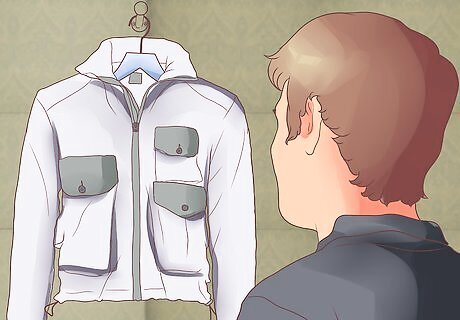
Check the jacket material. The tag or label on your jacket should state the materials it is made from and their relative proportions. A jacket that is 100% nylon should be relatively easy to dye, but if it is made from a synthetic blend that includes other materials (such as polyester or acetate, for example), then it may be more difficult to get the dye to stay.] Even if the jacket is made of a nylon blend, it will usually accept the dye if at least 60 percent of the jacket is made of nylon. Nylon blends are still dyeable as long as the other materials will also accept dye; examples include cotton, linen, silk, wool, ramie, and rayon. Some nylon is treated or coated for durability or stain/water resistance; this can prevent the material from accepting dye, so check the jacket label for this information, as well.
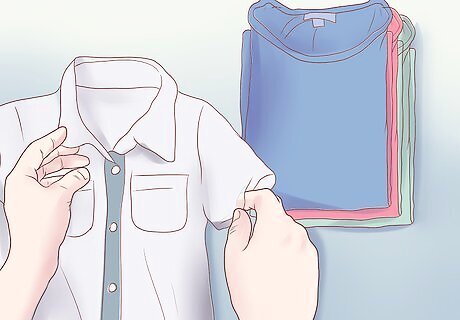
Consider the jacket's color. Even if your jacket is made of easily dyeable materials, its original color will significantly impact your coloring options. You should be able to dye a white or light grey jacket without much trouble, but if the jacket is another color then you might have some difficulty, especially if that color is already dark or intense. A white or off-white jacket will be easiest to dye, but you might also be able to dye over a light pastel color like a baby blue, soft pink, or buttercup yellow. Be aware, however, that the current color will alter the final appearance of the dye. If you do attempt to dye a jacket that is already colored, make sure your dye is bright or dark in order to cover up the old color.

Choose the right dye. Most standard chemical dyes can dye nylon, but you should make sure the one you choose will do this before you buy it. Most dyes will include information on the packaging about compatible materials; if you don't find this, check the manufacturer website. Standard Rit dye works on both natural and synthetic fibers, but some brands have separate formulas for each type of material. Always read the manufacturer’s instructions to verify that the procedure is doable for your particular jacket. If the manufacturer's instructions differ from those described here, follow the manufacturer. Many (though not all) fabric dyes come in powder form and must be mixed with water for dyeing.
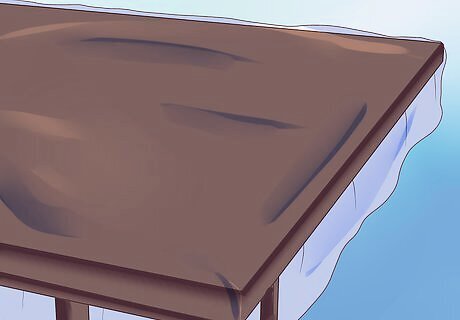
Protect your workspace. Dyeing is a very messy process and may stain certain surfaces. Protect the entire work area you plan to use by covering it with newspaper, plastic sheets, or some other drape or material that will not soak through if it becomes wet. Keep clean paper towels, a household surface cleaner, and a source of clean water nearby. If any dye splashes where it shouldn't, you can use these to clean it off before it sets in. Make sure to also protect your own clothing and skin by wearing rubber gloves, an apron or coveralls, and safety goggles. Even with all this protective gear, it is best to wear clothes you won't mind getting stained.
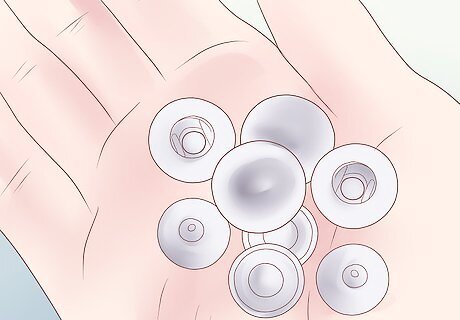
Remove jacket accessories. Anything that can be easily removed from your jacket and that you do not want to dye should be taken off prior to dyeing. For example, if your jacket has a zip-out liner that you don't need to color, take it out. The same goes for detachable hoods, zipper pulls, etc. This will help ensure that you don't use up any of the dye on parts of your jacket that won't be seen or which you want to remain their original color. If any removable parts of your jacket are black, take these off whether or not you wish to dye them -- dye will not show up on black nylon, anyway. Check your jacket pockets for any items that may have mistakenly be left inside. You don't want to end up with the melted remains of a cough drop or lip balm coating the inside of your pocket!
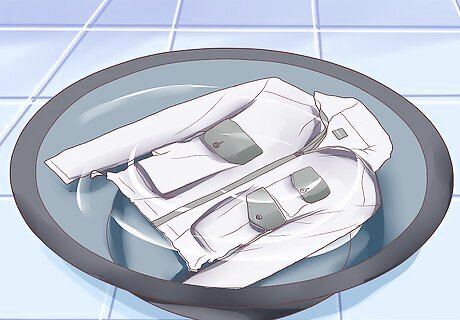
Soak your jacket. Immediately before you plan to dye it, completely submerge your jacket in warm water. This is recommended because wet fibers will absorb dye more evenly and thoroughly, resulting in a more professional-looking color job. Use a large bucket or deep sink for this task. Smooth out any wrinkles in the jacket material once you remove it from the water. This will help ensure that the dye evenly coats all surfaces of the jacket once you begin the dyeing process.
Dyeing Your Jacket
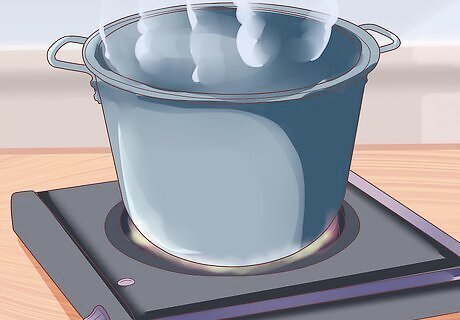
Heat a large pot of water. Fill a large, stainless steel pot with enough water to completely submerge the jacket. Place it on a stovetop over medium heat and bring it to a simmer or very low boil. There must be plenty of room in the pot for the jacket to move around underneath the water. Otherwise, the nylon may absorb the dye unevenly. You will need roughly 3 gallons of water for each package of dye you intend to use (but see the dye package for instructions). Using less water will create a stronger color; using more water will dilute the color. Ideally, you should use a pot large enough to be roughly three-quarters full once you have added the desired amount of water.
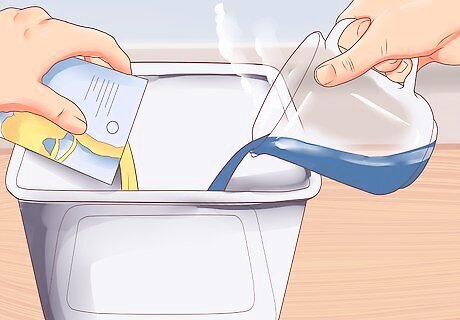
Dissolve the dye separately. Fill a separate container with about 2 cups of hot water (or whatever amount is recommended by the dye manufacturer). Stir one packet of powdered dye into the water until the powder is completely dissolved. For liquid dye, you should still mix it, stirring until it is well-blended with the water. You should not put powdered or liquid dye directly onto the jacket material unless you are going for an "artistic" look with uneven coloring.
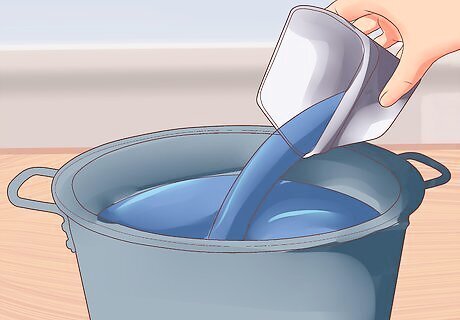
Mix in the dye. Pour the pre-dissolved dye into the pot of simmering water. Take a few moments to stir the concentrated dye into the water, allowing it to disperse evenly. This creates the "dye bath," and it is an important step for creating the most even coloring possible. If you do not have a pot big enough to hold the appropriate amount of water plus your jacket, you can pour the simmering water into a plastic bucket or tub before mixing in your dissolved dye. Do not use fiberglass or porcelain sinks or tubs for this, as they may stain. For best results, the dye bath should be kept warm (about 140 degrees Fahrenheit) during the dyeing process, so consider this fact when deciding whether to use a stovetop pot versus a separate container.
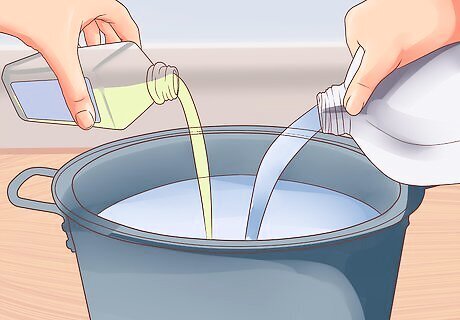
Add vinegar to the dye bath. Add 1 cup of distilled white vinegar per 3 gallons of dye bath. This helps the dye cling to the nylon fibers in the jacket and will produce a more intense result. If you don't have any vinegar, you can still dye your jacket. However, you may end up with a tint that isn't as deep as you could have otherwise achieved.

Submerge the jacket in the dye bath. Slowly and carefully lower the jacket into the simmering dye bath, pressing it down into the water until the entire thing is submerged and covered by dye. Let the jacket "cook" in the dye bath for up to one hour, stirring or agitating the jacket constantly. Don't just put the jacket in the pot and trust that it will sink itself; any air trapped under the jacket will make it float and result in uneven coloring. Use a large spoon or disposable chopsticks to press the jacket down into the dye bath. This will prevent you from getting burned by the hot water and will keep your hands from getting stained. Once the material is soaked thoroughly, the jacket should stay submerged beneath the dye bath surface. Keep stirring it around in the dye bath to ensure that all surfaces are evenly coated. Your jacket color will turn out brighter (or darker, depending on the color of dye) if you leave it in the dye bath longer. Note that the color will always look darker after soaking than it will when the process is completely finished.
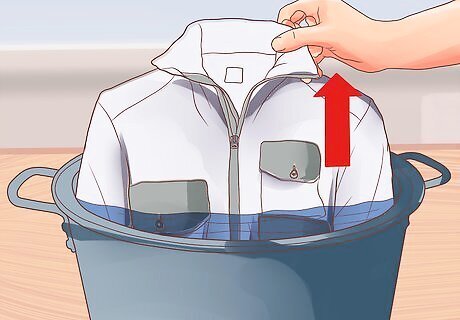
Remove the jacket from the dye bath. Turn off the stove, then use two spoons or gloved hands to carefully lift the jacket out of the dye bath and into a stainless steel sink. Be sure to hold an old towel or plastic sheet underneath the jacket as you move it out of the pot to keep the dye bath water from dripping on the floor or countertop. It might be a good idea to take the pot to your laundry room sink and drop the jacket into that one instead of the one in your kitchen, especially if your kitchen sink is porcelain or fiberglass. If you don't have a sink or wash basin that can be used for this, take the entire pot (with the jacket still in it) outside and hold it over the ground before removing the jacket.
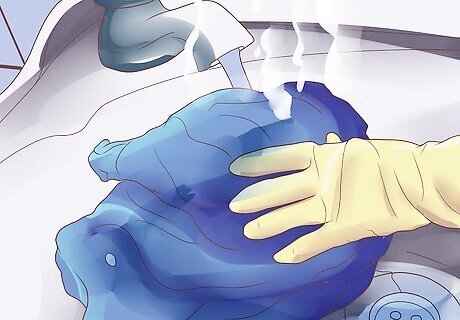
Rinse with hot water. Rinse the jacket under hot, running water, dropping its temperature gradually. This serves to get rid of excess dye. If you do not have a sink in your home you can do this in, a garden hose outside will suffice; however, you won't be able to use hot water. Rinse the jacket until the water running off of it is clear. Once the water runs clear, briefly rinse the jacket with very cold water; this helps to set the dye into the nylon fibers. Even though the excess dye should now be removed from your jacket, you should hold an old towel under the jacket while transporting it to ensure no tinted water drips on your floor.

Clean up the area. Carefully dump the dye bath down the drain of your laundry sink. It is best to avoid pouring all that dye down your kitchen or bathroom sink, especially if they are made of stainable materials (such as porcelain). Dispose of any towels or plastic sheets that got dye on them during the process (or set them aside for separate cleaning). If you don't have a laundry room sink, you can pour the dye bath into the floor drain of a cellar or basement. If you must pour the dye bath down a bathroom toilet or tub drain, you will need to then immediately clean the area with a bleach-based cleaner. If the dye dries, it'll likely create a permanent stain. If you dump your dye bath outside, make sure you flush the ground with plenty of clean water to dissipate the dye; don't do this on cement or gravel, as the dye will stain it, too!
Preparing to Wear Your Jacket
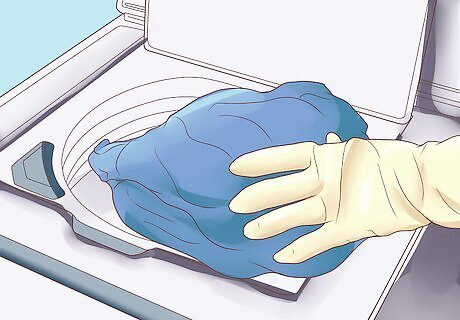
Wash your jacket. Place the newly dyed jacket in your washing machine and wash it by itself with a normal amount detergent and cold water. This helps to further remove any excess dye and prepare your jacket to be worn without staining the clothing it touches. Be advised that unless your washing machine has a stainless steel drum, this process could permanently stain the inside of your machine. If you are concerned about this, hand-wash your jacket instead. After this first washing, you should be able to wear it. However, your jacket should still be washed on its own in cold water for the next two or three washes because some residual dye could still bleed off in the water. Always check your jacket tag before washing it and follow the manufacturer's care instructions. If your jacket is "hand-wash only," do not put it in the washing machine.
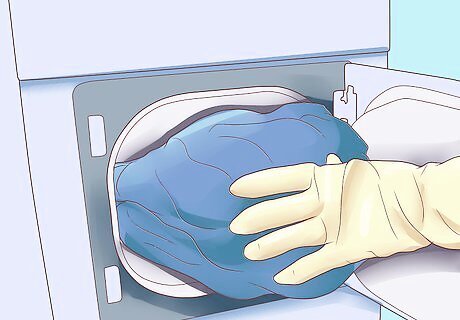
Dry the jacket. Toss the jacket into a dryer and tumble dry on low heat. Once the jacket is completely dry, it should be ready to wear. In order to further prevent potential dye bleed-off, dry the jacket by itself. Hang dry your jacket instead of machine drying it if the care tag says to do so. If you hang the jacket to dry, place an old towel beneath it to catch any dye that might drip off.
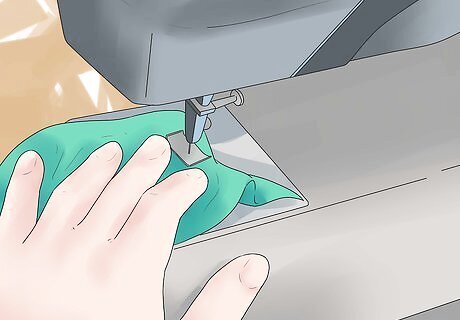
Replace detachable accessories. If you removed anything from your jacket before dyeing it (such as a hood, zipper pulls, or a jacket liner), you may now put those items back onto your jacket. At this point, there should be minimal risk of staining these accessory items by letting them touch and rub against the dyed jacket. If you are concerned that contact between your dyed jacket and an un-dyed accessory item could cause some coloring to rub off where it shouldn't, wait until you've washed the jacket a few times before replacing these items.
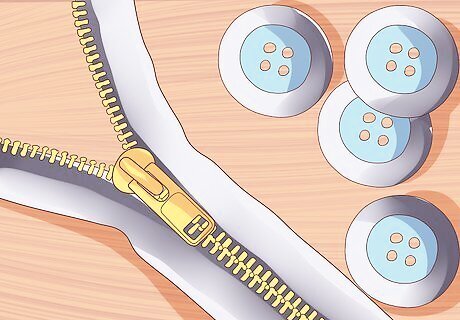
Swap out buttons and zippers if needed. If you don't like the match-up between your jacket's new color and the color of its buttons and zippers (which will not dye), you can swap out many of these objects to match the new color scheme. For example: Unstitch or carefully cut out the old zipper, then sew in a new zipper that measures the same length as the old one. Cut the thread holding any old buttons in place. Grab new buttons that match your newly dyed jacket and sew these buttons in the same places the old buttons were.




















Comments
0 comment